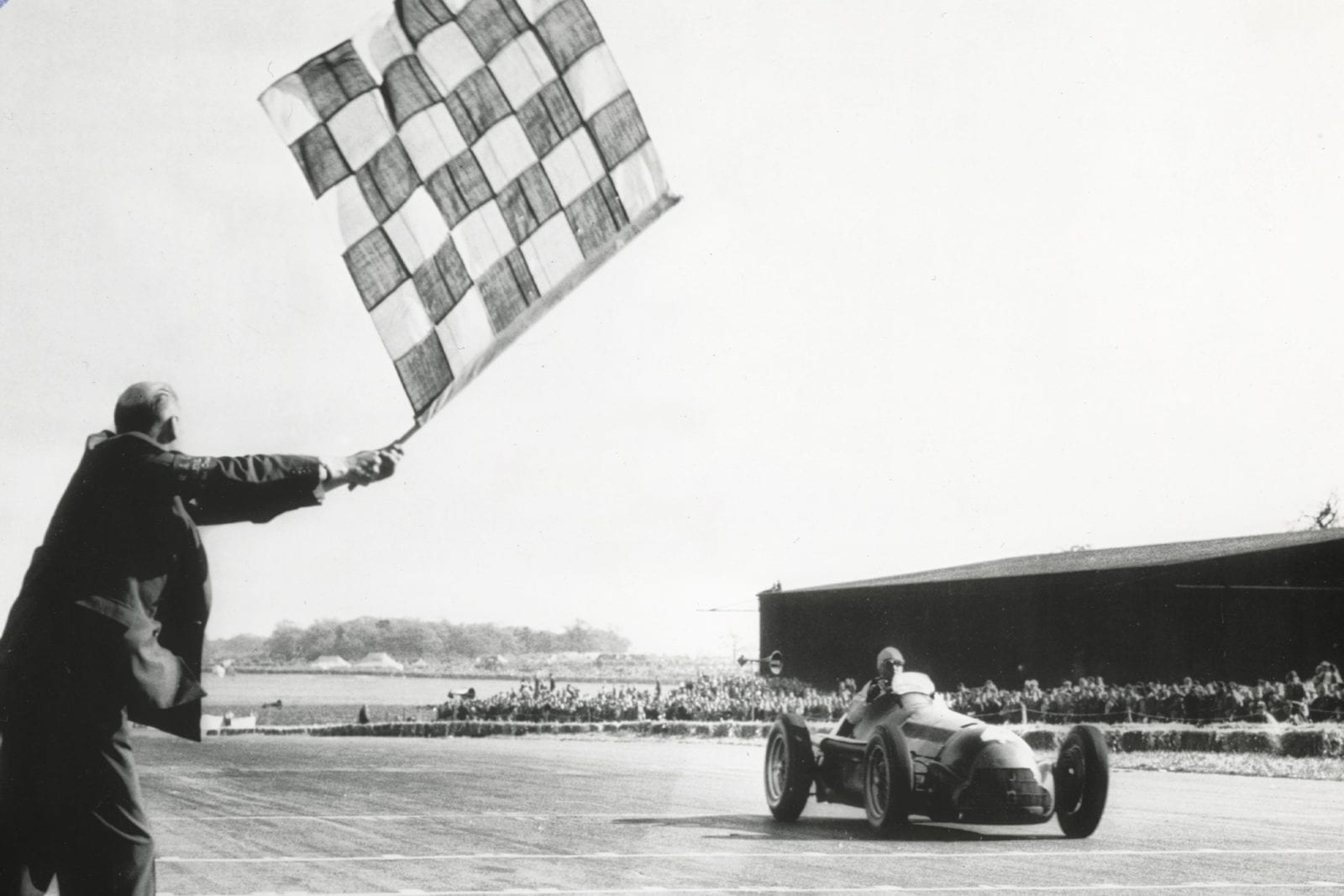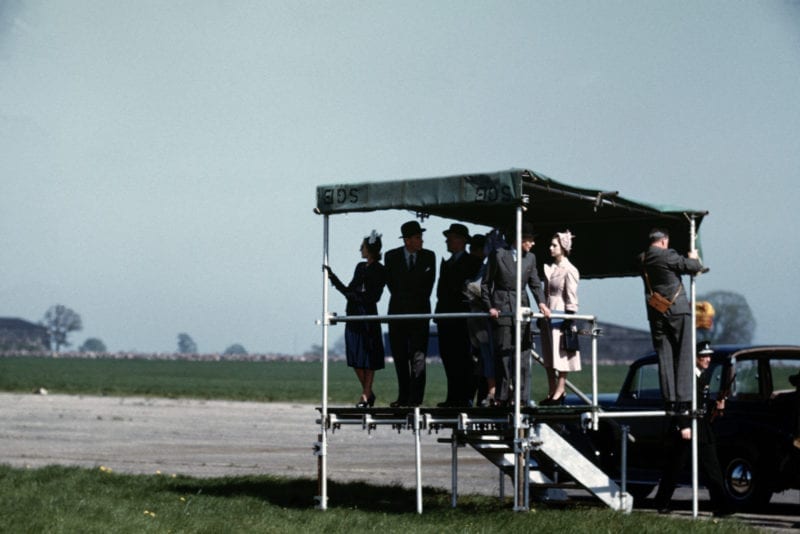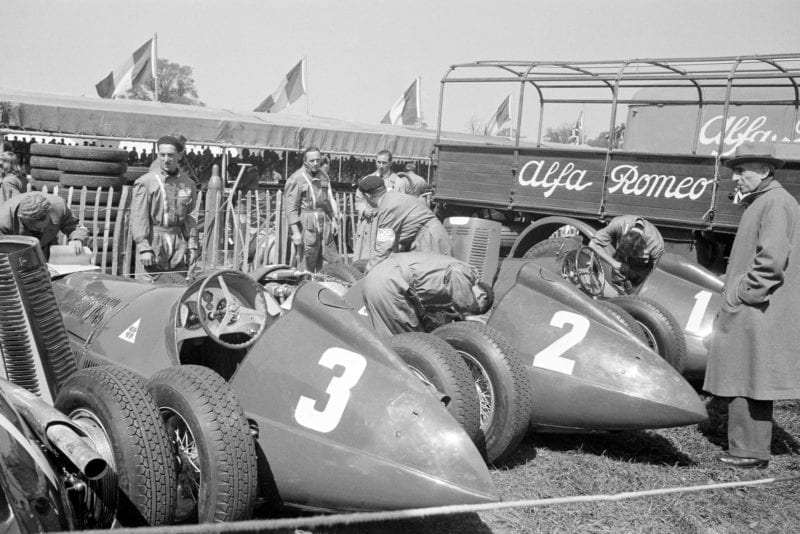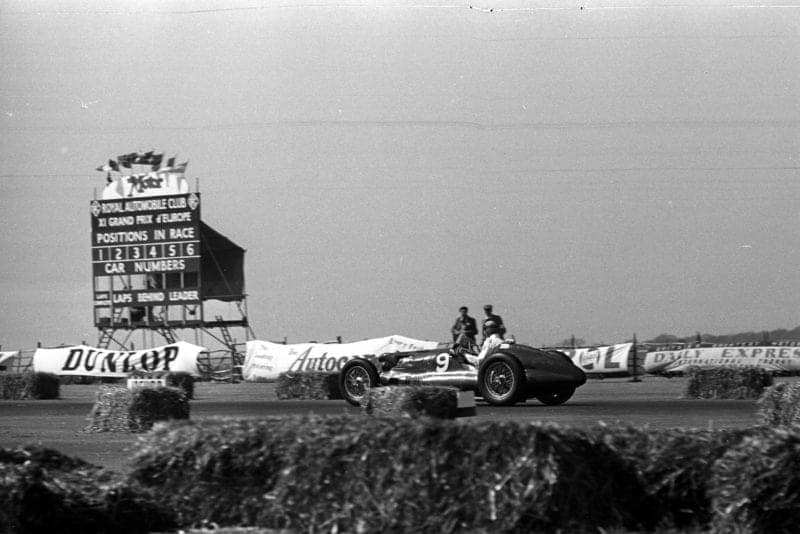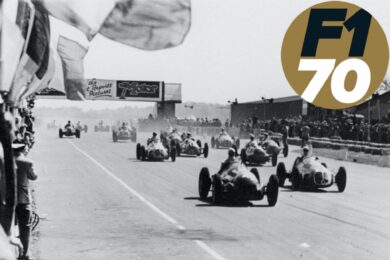In the first heat the Coopers of Potts, Collins, Symonds, Fergusson, Headland, Hunter, Moss, D. Brown, A. E. Brown, Braid, Cox, Reece, Samuelson, Watkins, Whitehouse and Winterbottom were to meet Bosisto’s Arengo, the Adams-Wood, the Messenger, the C.F.S., Fry’s Parsenn, the Cobra, Aikens’ Cooper-like Iota, the F.H.B., the Grose, the G.S. 3, and the Bardon-Turner. Before the wonderful rolling start behind Col. Barnes Sunbeam-Talbot Fergusson warmed his transmission on the jack and Wood carefully locked the detachable steering wheel of the Adams-Wood. Moss had a lucky horse-shoe insignia on his Cooper and A. E. Brown’s crew all wore bright blue overalls. The G.S. 3 had a truly intriguing oil-cooler rather bigger than its Norton cylinder. Potts’ Cooper showed evidence of having been on fire; the Messenger had big air-scoops to its tail.
As the packed mass of multi-coloured cars roared forward, inches only between some of them, Hunter’s Cooper led Whitehouse’s, both from the front row of the grid. Behind roared the pack, all save Wood, whose fuel wouldn’t get through.
After a lap Aikens’ Iota just led Moss’ Cooper, Whitehouse and Brown locked in combat behind. Spink nearly lost the G.S. 3 and already the F.H.B. and Messenger were virtually out of the running. On lap two Moss went ahead, chased by Brown and Aikens, and Headland’s golden Cooper slid, corrected, slid again approaching Woodcote corner, spun, and slid tail-first through the straw bales. He restarted but later repeated the performance somewhere else, squashing the tail completely. At the end of lap three the leaders were the same, but Whitehouse came right up to pass Moss and Brown, with Aikens fourth. However that didn’t suit Stirling and he caught the rival Cooper. Cox, Reece, Headland, Fergusson, Samuelson, Watkins and the Cobra had all ceased to motor and the F.H.B. lacked some necessary cogs.
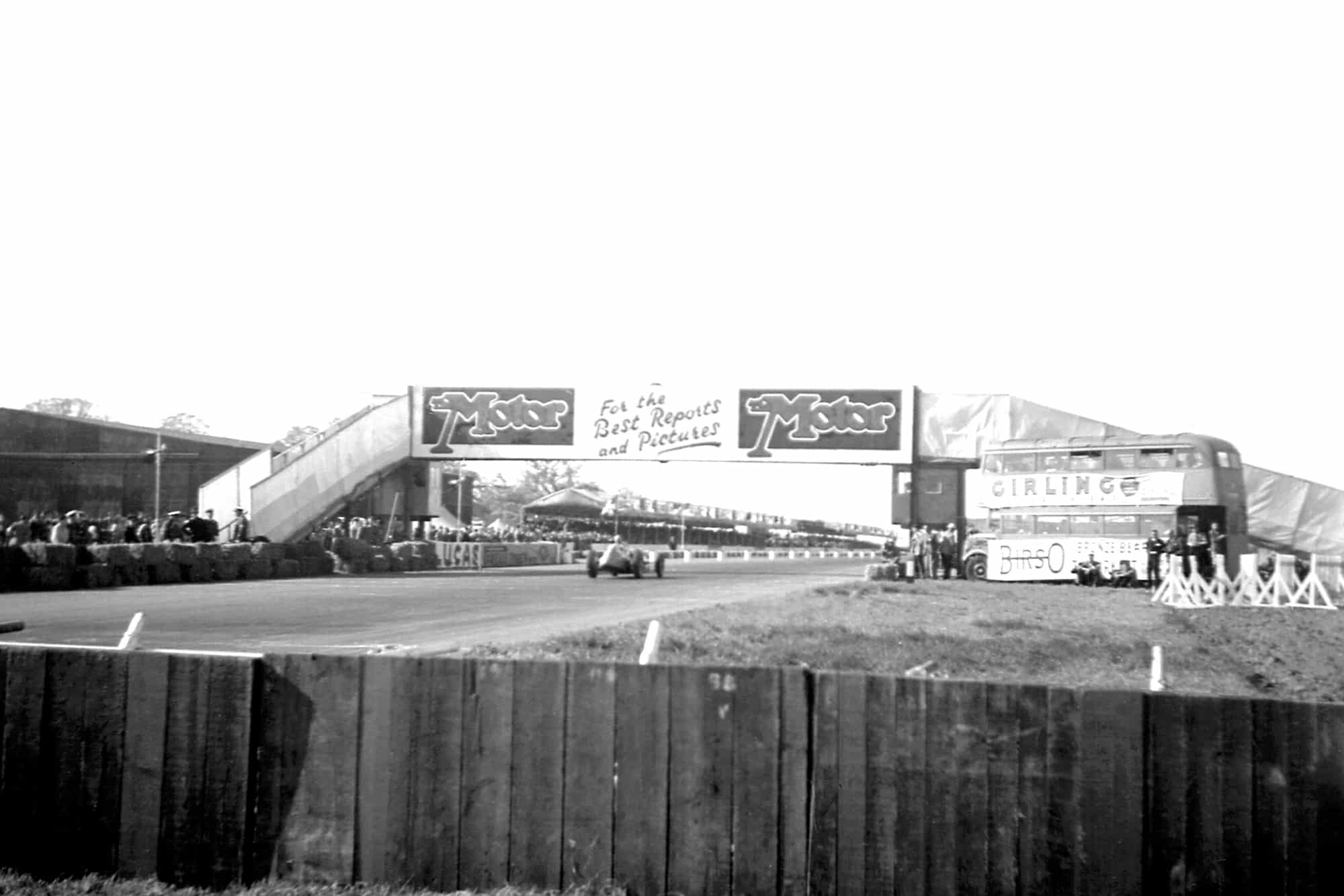
Results
1st: S. Moss (Cooper-J.A.P.), 11 min. 11.8 sec. – 77.4 m.p.h.
2nd: W. J. Whitehouse (Cooper-Norton), 11 min. 12.6 sec.
3rd: A. E. Brown (Cooper-J.A.P.), 11 min. 13.0 sec.
Heat two saw the Coopers of Dryden, Kearon, Christie, Brandon, Aston, Page, Coldham, Cooper himself, Rippon, Carter, C. N. Cooper, Leonard, May, Prosser, Tye, Westwood and Wharton up against Fry’s Arengo (remember Lulsgate !), the f.w.d. Emeryson, the f.w.d. Bond with vast exhaust pipe, the Cutler, Moor’s Arengo, the J.B.S., two Kiefts, the Parker and Underwood’s Iota. Alas, the Trimax of Rhiando was amongst the non-starters. Again they came round on that fantastic rolling lap, but the Cutler was already in trouble. The sight of that tightly-bunched pack surging forward made strong hearts misfire, especially as Dryden was seen to be fighting a series of slides, in second place behind John Cooper, Aston third. A lap later it was : Cooper, Emery, Parker, Aston.
We have known for a long time that the Emeryson-Norton corners remarkably fast, and Paul was certainly trying. He was closer to Cooper at the close of lap two, but after another lap he had dropped behind Parker, but attempted to pass outside at Woodcote. It was furious racing, each man for himself and at Stowe Emery overdid it and the straw-bales bowled him over, all the steering wheel spokes being smashed from his hands as the car rolled over. He suffered lacerations, but is on the way to recovery. Brandon had been holding fifth place and now moved up to finish third in front of Aston.
Results
1st: J. N. Cooper (Cooper-J.A.P.), 11 min. 8.2 sec. – 78.12 m.p.h.
2nd: D. Parker (Parker-J.A.P.), 11 min. 9.6 sec.
3rd: E. Brandon (Cooper-J.A.P.), 11 min. 10.0 sec.
Note the close finishes, which gave the final added excitement; 19 Coopers lined up with the Parker, Iota, C.F.S., Kieft, Grose, Messenger, two Arengos, Moor’s white Arengo, and the Bond. At the commencement John Cooper led Whitehouse and Parker. Prosser’s Cooper started badly and the C.F.S. and Page’s Cooper were already outpaced. After a lap Cooper was just ahead of Whitehouse, Aikens third, then Aikens came right through to lead in the Triumph-engined Iota, driving the race of his life, the car sliding alarmingly and Moss watching his every move a few feet behind! Parker was now third, Cooper fourth, but on lap three these two transposed themselves, until Parker retired on the following lap. Moss passed Aikens on lap four, but the Wing-Commander re-passed. Moss led again on the next lap, but again the Iota got past the Cooper-J.A.P., snaking wildly as it cornered. Parker was back in third place and Collins’ Cooper was moving up fast. Moor’s Arengo, its side dented, was faltering and Whitehouse was flagged in with a trailing air-scoop. The C.F.S. was in trouble, May retired and Brown’s Cooper hit the Stowe straw-bales. Meanwhile the battle waxed as furious as ever, Aikens holding off Moss’ Cooper and Stirling, trying all he knew, having his piston seize. He held his place, but Aikens had the lead he wanted, winning by 2.2 sec. He thoroughly deserved to win and no one will acknowledge the interest that a break in the long-list of Cooper successes will bring more readily than Cooper themselves.
Results
1st: W/Cdr. F. Aikens (Iota-Triumph), 21 min. 51.6 sec. 79.29 m.p.h.
2nd: S. Moss (Cooper-J.A.P.), 21 min. 53.8 sec., 79.15 m.p.h.
3rd: P. J. Collins (Cooper-Norton), 21 min. 54.0 sec., 79.14 m.p.h.
4th: D. Parker (Parker), 22 min. 2.2 sec., 78.65 m.p.h.
Then the following in this order : Aston (Cooper), J. N. Cooper, Brandon (Cooper), Carter (Cooper), Hunter (Cooper), Prosser (Cooper), Leonard (Cooper), C. N. Cooper (Cooper), D. Brown (Cooper), Fry (Arengo), Christie (Cooper), Dryden (Cooper), Whitehouse (Cooper), Bosisto (Arengo), Stoop (C.F.S.), Rippon (Cooper), Page (Cooper), Kearon (Cooper), and Messenger (Messenger).
The Grand Prix
Before the Final the B.R.M. which had arrived in a “transporter” presented by Austin, was demonstrated by Raymond Mays. It was announced that one or more of these cars will make an initial appearance in the B.R.D.C. Daily Express Meeting at Silverstone on August 26th, possibly after high-speed testing on the Continent. So now we know ! Mays’ car was painted in light green and beautifully turned-out.
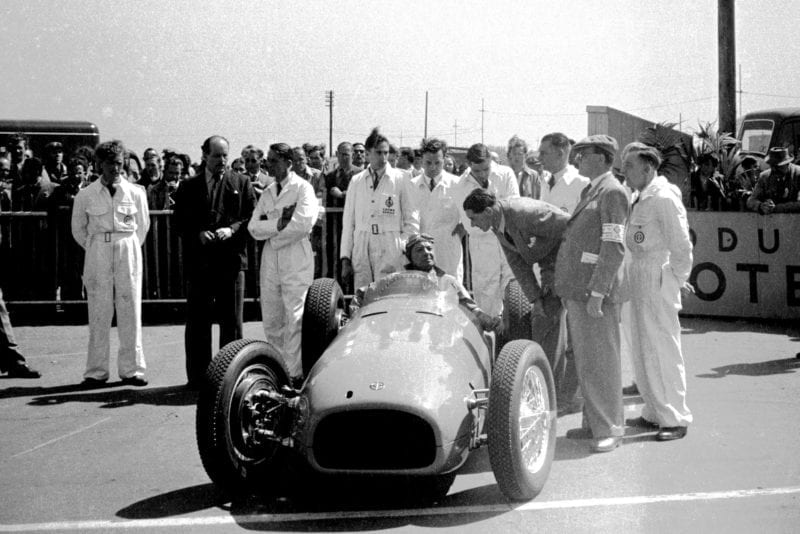
Raymond Mays demonstrating the BRM
Getty Images
After lunch the Royal Party toured the 2 mile 1,564 yard circuit and the drivers were presented to them by Earl Howe. Their Majesties spent a very considerable time talking with each man and everyone will agree that never had the Royal family looked nicer, or to be enjoying themselves so much ! They eventually took their places in the Royal box, after the officials of the F.I.A. had been presented to them. The band of the Grenadier Guards played, flags of half-a-dozen nations fluttered in the breeze, and the mechanics, those of Alfa-Romeo in blue Pirelli overalls, accompanied by Ramponi, walked to their cars. Earl Howe, sitting between the King and Queen, explained the procedure and as the flag was about to fall the King looked up from his programme and eagerly down towards the starting grid. As the cars roared away he appeared to be keenly interested, but the noise and smoke took the Queen a trifle unawares, as the mass-start of a race does to those close to the course. A moment later she, too, was following the progress of the field, while Princess Margaret seemed to want to concentrate solely on what was happening, and to regard conversation as merely incidental. But this is to anticipate.
They lined up as follows : —
Front row :
Parnell (Alfa Romeo) Fangio (Alfa-Romeo) Fagioli (Alfa-Romeo) Farina (Alfa-Romeo)
Martin (Talbot) Cabantous (Talbot) “Bira” (Maserati)
Chiron (Maserati) Walker (E.R.A.) Rosier (Talbot) de Graffenreid (Maserati)
Etancelin (Talbot) Gerard (E.R.A.) Johnson (E.R.A.)
Murray (Maserati) Crossley (Alta) Hampshire (Maserati) Harrison (E.R.A.)
Claes (Talbot) Fry (Maserati) Kelly (Alta)
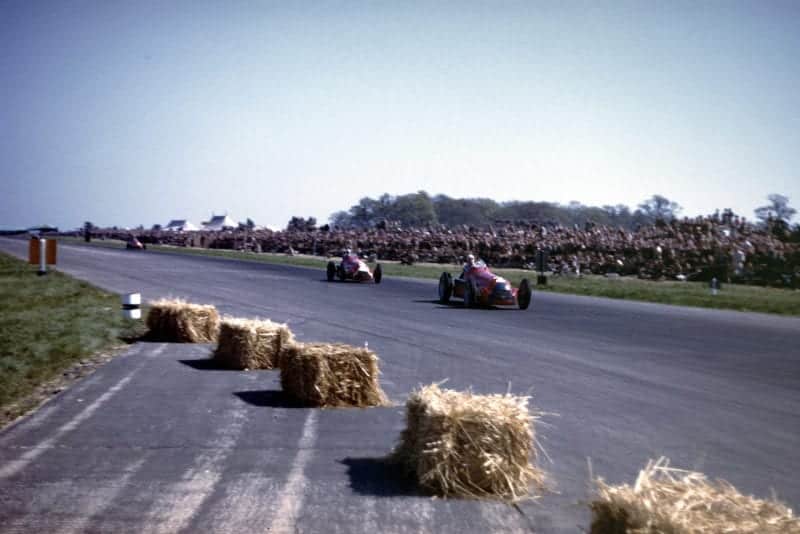
Farina leads Fagioli
Getty Images
Mays chatted with Farina. Claes’ mechanics wheeled out their Monoplaque starting battery in a yellow trolley to match his car, and zero hour came nearer. Then the flag fell and in a crash of sound and eddies of smoke-haze they were away. Farina was well in the lead, chased by Fagioli. Fangio and Parnell.
But what is this? Already Walker’s E-type E.R.A. is at its pit, and smoke is pouring from Johnson’s. Past Woodcote corner Johnson sees flames amid the smoke and steers the car on to the grass, stumbling from the cockpit before the car has stopped. He is unhurt and walks back to his pit, but the E-type hoodoo has returned; the supercharger is useless. Walker goes on after 40 sec., but Rolt is driving and soon he, too, retires, with gearbox trouble.
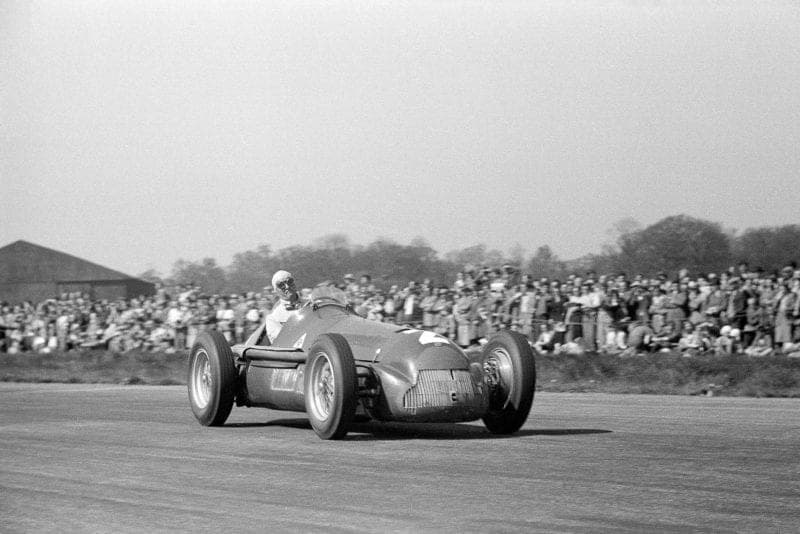
Farina was first to lead the dominant Alfa Romeo charge
Getty Images
Thus early the race is robbed of all real interest and we settle down to see a demonstration of Italian supremacy that is to cost £1,000 in prize money, apart from starting-fees. The 500-c.c. racing was really much more exciting, although no insult to the Italians is implied — indeed, Farina has done his second lap at 94.02 m.p.h.
Another car cut of the race for good so early in the afternoon is Martin’s Talbot, with oil outside instead of inside the engine. The Alfa-Romeo team are having grand fun amongst themselves, driving superbly, the cars sounding grand. After five laps the order was Farina, Fangio 0.6 sec. behind, Fagioli, Parnell. ” Bira ” lay fifth, in front of de Graffenried, who was shielding his face from oil-mist. Parnell, in a blue crash hat, visor and overalls, sat low and at ease. Farina leaned back stylishly, the burly Fagioli was more upright and leaned forward to change gear, and Fangio, in linen helmet and a coloured collar showing above his overalls, took much the same attitude as Parnell.
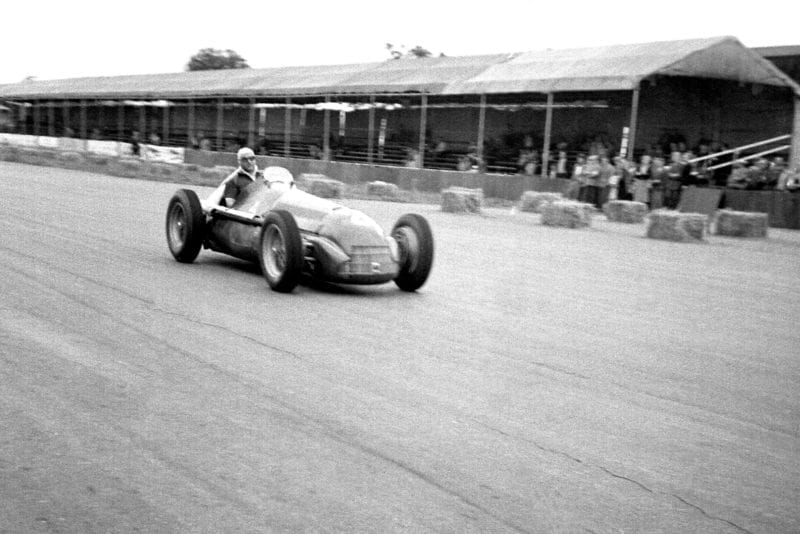
Fagioli, with upright stance, was one of the Alfas to lead
Getty Images
Ten laps, and it was Fagioli, a mere 0.4 sec. ahead of Farina, then Fangio and Parnell. Five more laps and Fangio led by 0.2 sec. in this ding-dong place-changing Farina went ahead again, by a second, after 20 laps, and de Graffenried had abandoned his Maserati at Abbey Curve with a broken con.-rod, letting Cabantous, who peered sternly from his Talbot’s cockpit, into fifth place behind “Bira.” Gerard was content to tail Harrison, away in the background. But the note of his E.R.A. spelt Reliability and his driving looked safe as houses. Fagioli was 0.4 sec. in front of Farina after 25 laps, having averaged 91.66 m.p.h., and it was obvious that the Alfa-Romeo team had been instructed how to finish—Farina 1st, Fagioli 2nd, Fangio 3rd and Parnell 4th – but to appear to be racing to please the crowd.
A hare had dented the cowling of Parnell’s car, but otherwise all was well and Reg. driving with confidence. Behind, troubles were beginning. Chiron’s Maserati was throwing oil but he pulled up, refuelled and went on, only to retire before 4 p.m. with oil in the clutch and a broken gearbox. Kelly also had clutch trouble but resumed, later refuelling with 150 litres of petrol in 24 sec. After 30 laps only 17 cars were left, and Farina was 2.8 sec. ahead of Fagioli. Fangio had a spell in second place, 1.8 sec. behind Farina at 35 laps, but always Parnell was fourth. Fangio appeared to be chasing Farina, closing to 0.4 sec. at 40 laps, the leader’s average 90.84 m.p.h.
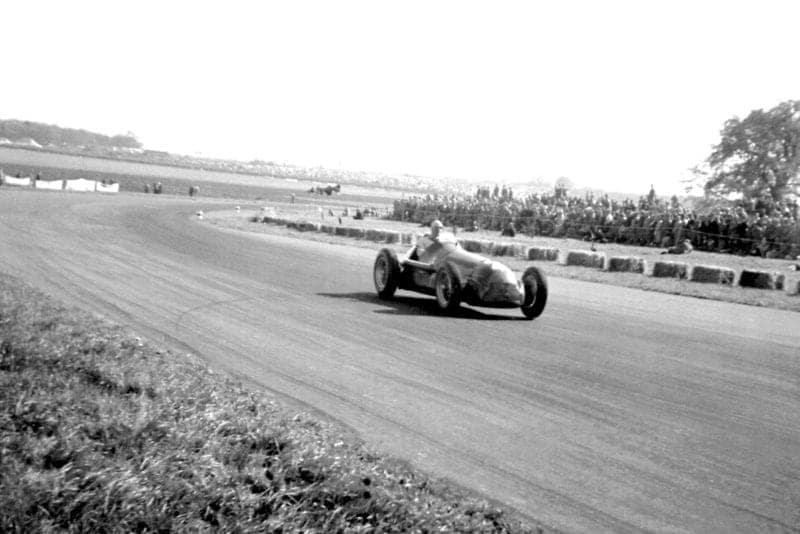
Farina at Abbey Curve
Getty Images
“Bira’s” Maserati had stopped, coming down Hangar straight, and although officials pushed it to Club corner, then to Abbey, and tried detaching the wire to the magneto switch, fuel starvation ended the Prince’s fast, steady drive. Rosier, too, had speeded up and was sixth, behind Cabantous.
The Alfas refuelled slickly, Fangio’s, Fagioli’s and Farina’s taking 25 sec., Parnell’s 30 sec. Etancelin changed a plug, Fry’s Maserati was refuelled in 51 sec. and taken on by Shawe-Taylor (how nice for you to be in a ” modern “ car, S.-T.!). and Crossley’s Alta wasted 125 sec. because his pressure-hose system failed. Hampshire took on fuel and oil in 30 sec., Murray doing likewise in 54 sec. The latter, however, soon retired with a defective engine and Crossley stopped by Copse Corner.
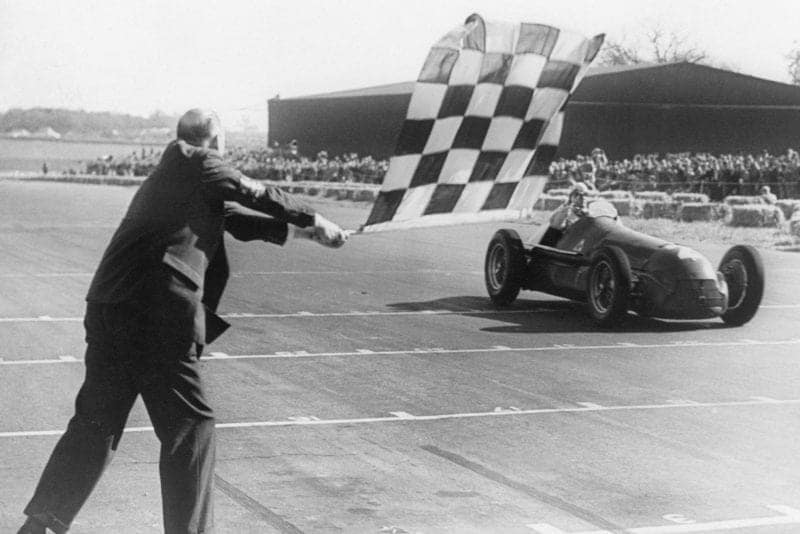
Farina takes the flag to win at Silverstone
Getty Images
Fifty laps saw Farina 1.2 sec. behind Fangio, the average up to 91.01 m.p.h., but five laps later Fangio was 2.6 sec. behind, although Farina wasn’t going perceptibly faster. Then the Argentinian closed, during the following five laps, to within 0.6 sec. of Farina. Then he made a mistake, hitting a straw-bale at Stowe. He never recovered from this episode for his engine note became rough and he retired with a broken con.-rod. Five laps from the finish Fagioli was 41.8 sec. behind Farina, but he closed this gap to 2.6 sec. going over the line. Parnell was a well-deserved third, Cabantous held his fourth place from Rosier, the Talbots having run exceedingly well, and great hand-claps greeted Gerard’s arrival in sixth place, first Britisher in a British car to finish, for which he takes the Fred Craner Memorial Trophy.
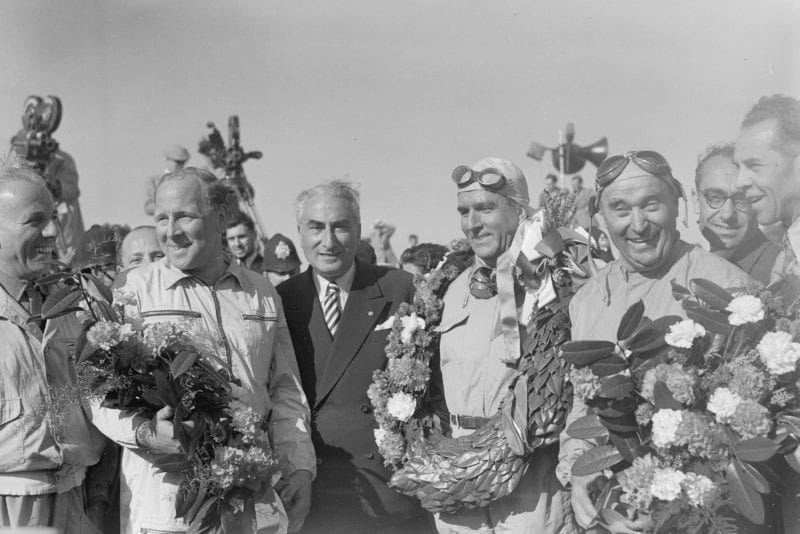
The victorious Alfa team: Parnell, Farina and Fagioli
Getty Images
The R.A.C. G.P. de l’Europe, then, was no better than preceding races in the series, a sentiment with which we feel sure those who arrived late because of traffic congestion, those who spent four hours or so getting out of the car parks, those who received the wrong passes and those honorary club marshals who had to sleep the Friday night in old tents because R.A.C. patrols had taken the beds in the huts, will readily concur.
Results
1st : Farina (Alfa-Romeo), 70 laps completed, 2 hr 13 min. 23.6 sec. (90.95 m.p.h.)
2nd : Fagioli (Alfa-Romeo) 70 laps completed, 2 hr. 13 min. 26.2 sec. (90.92 m.p.h.)
3rd: Parnell (Alfa-Romeo) 70 laps completed, 2 hr. 14 min. 15.6 sec. (90.37 m.p.h.)
The following in this order: Cabantous (Talbot), 68 laps completed; Rosier (Talbot), 68 laps completed; Gerard (E.R.A.), 67 laps completed; Harrison (E.R.A.), 67 laps completed; Etancelin (Talbot), 65 laps completed; Hampshire (Maserati), 64 laps completed; Fry (Maserati), 64 laps completed; and Claes (Talbot), 64 laps completed.
